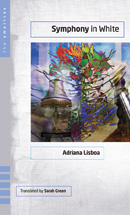
Symphony in White is a tale of two sisters. Clarice and Maria Inês, daughters of Afonso and Octacilia Olimpio, came of age in Brazil in the 1960s and 1970s during the period of military dictatorship. Lisboa does not directly comment upon the political situation in Brazil during that time, but the political repression is mirrored in the stifling atmosphere of the Olimpio family and the secrets they keep.
At the age of fifteen, beautiful and obedient Clarice, a model child, was sent suddenly to Rio to live with her great-Aunt Berenice and complete her education. Nine year-old Maria Inês, strong-willed and independent, with dreams of becoming a ballerina, remained at home to torment her parents with her insolence. Yet in middle-age, Clarice has divorced her husband and become a sculptor, while Maria Inês, also educated in Rio, has chosen a safe life—she becomes a dermatologist; marries João Miguel, her childhood playmate; and lives the life of a socialite.
The novel opens in rural Brazil where Clarice and Maria Inês were born and spent their childhood. It is now forty-some years later. Clarice and the aging artist Tomás, who lives in a farmhand's cottage on what is left of the Olimpio estate, await the arrival of Maria Inês and her daughter Eduarda. Lisboa moves back and forth through time and space, weaving the memories of the characters and the actions of the past and present into a seamless composition. The reader learns in the first chapter that Clarice has scars on her wrists, that Maria Inês has married her second cousin, João Miguel, now on his way to visit his father in Italy, and that Tomás is still obsessed by the image of the young woman he first knew and loved in Rio de Janeiro.
A central image in the novel is J.M. Whistler's painting, Symphony in White, No. 1: The White Girl. It is this image that Tomás calls up when he thinks of the first time he saw Maria Inês in the window of her great-Aunt Berenice's apartment in Rio. As Whistler used musical correlations in his paintings, so Lisboa constructs her Symphony in White with musical motifs that repeat and echo through the novel as the lives of Clarice and Maria Inês are revealed. (Lisboa has a degree in music and once performed as a jazz singer in Paris.) In a manner somewhat reminiscent of Toni Morrison's technique in her novel Jazz, the major characters in Symphony in White are given opportunities to play their own riffs.
Symphony in White is Lisboa's second novel, and her first to be translated into English; the book was awarded the Jose Saramago Prize in 2003 and has been widely praised for its lyricism and descriptive power. It is a book that draws the reader in to discover the hidden secrets of despair, joy and survival.

Texas Tech University Press, hardcover, 9780896726666
